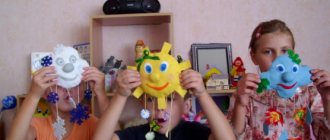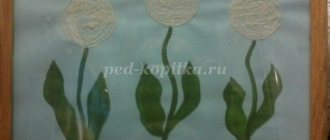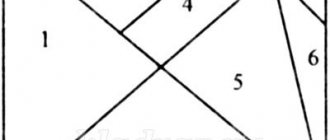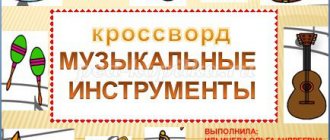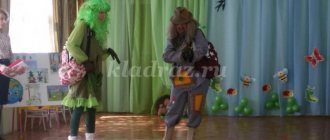Summary of a walk in the senior group
IN:
Well done and remember the last month of winter - February.
In February there are still frosts, a blizzard is raging, strong winds are blowing, but you can already feel the approach of spring. People say: “In February there are two friends - frost and blizzard.” Guys, let’s check with you to see if there is “frost” outside today. I suggest you conduct an experiment. What did you and I do to avoid freezing? Children:
Dress warmly.
Research activities (observation).
IN:
I have water and a handkerchief in a cup, I will dip the handkerchief in the water and hang it on a rope and after a while we will see what happens to the handkerchief. (the teacher performs the actions). In the meantime, while we have the scarf hanging, I suggest the boys work hard.
Labor activity
: clear the path.
Individual work with a subgroup of children:
While the boys are working, individual work on internal affairs is being carried out with a group of girls. Throwing exercise. The girls are divided into two teams and lines are marked on the track. Teams stand on one side, hoops lie on the other. Assignment: each person has two (bags) of snowballs, alternately throw the snowballs with the left and right hands, try to fall into the hoop. If other children express a desire to play, then I do individual work with them.
After a short amount of time, the children are called.
IN:
Let's remember what games you know.
D
They call it games.
Educator:
Well done, I suggest you play the game: “Frost—Red Nose.”
Outdoor game "Frost - Red Nose"
Children choose a driver using a counting rhyme. Two houses are designated on opposite sides of the site, and the players are located in one of them. The driver, “Frost-Red Nose,” stands in the middle of the court facing the players and says:
“I am Frost—Red Nose.
Which one of you will decide
Set off on a path? »
The players answer in chorus:
"We are not afraid of threats,
And we are not afraid of frost.”
After pronouncing the word “frost”, the children run across the playground to another house, and the driver catches up with them and tries to touch them with his hand - “freeze”. The “frozen” ones stop at the place where they were touched and remain in place until the end of the run. Stop the game. “Frost” counts the number of “frozen” ones. They choose a new driver, “Moroz”. At the end of the game, they compare which driver - “Frost” - froze more players. We play 2 times.
IN:
Let's play the new game "Penguins and the Bear".
Goal: to teach children not to run outside the playground, to cultivate friendliness and attention to each other, to practice running while dodging, and spatial orientation.
Players walk in a line one after another, imitating the gait of penguins (knees together, arms pressed to the body, palms parallel to the ground, walking in small steps) and say:
CHILDHOOD GUIDE
Summary of a morning health walk
for older children
Pentina Elena Veniaminovna,
teacher of MBDOU No. 25,
Monchegorsk, Murmansk region.
Program content : to develop in children the ability to hear the sounds of nature, to see the beauty of the sky, to develop creative imagination, to arouse the desire to fantasize, etc. to teach preschoolers to differentiate the animal world into categories - earth, water, air; develop motor activity of children.
Integration of educational areas: “Speech development”, “Physical development”, “Cognitive development”, “Social and communicative development”.
Educational area “Speech development” - didactic ball game “Air, earth, water”.
Educational area "Physical development " - game activities: "Winter dodgeballs", obstacle course - snake running, "Who is faster!"
Educational area “Social and communicative development ” - cleaning the kindergarten site, establishing safety rules for using a compass.
Educational area “Cognitive development” - observing clouds (cognitive conversation), experimental research activities - determining the direction of movement of clouds using a compass.
Structural parts of the walk:
- Cloud watching.
- Experimental research activity - direction of movement of clouds using a compass.
- Labor activity – cleaning the kindergarten area
- ATS: obstacle course “Snake” running (snow banks), competition “Who is the fastest!” - practice running, overcoming boundaries.
- Didactic ball game “Air, earth, water” (children’s subgroup)
- Game activity: “Winter dodgeballs” running with dodging - exercise running, agility, endurance.
Walking equipment:
For experimentation - a compass; shovels according to the number of children - for labor activities, ice cubes - for sliding downhill, flags for the police department "Who is faster!", an obstacle course (snow banks), a ball for the game "Winter Dodgeball", a ball for the didactic game "Air, Earth, Water" "
Walking progress:
- Cloud watching
Educator: Today you and I will be little researchers and observers, and today we will watch the clouds. Admire the beauty of the daytime clouds illuminated by the rays of the rising sun.
Clouds to any country
Through mountains, oceans
Can easily fly:
Higher, lower - whatever you want!
The sky is all free for them!
- Guys, what is a cloud? (these are white or gray formations)
— What does a cloud consist of?
- What do you think the cloud will be like if you touch it?
- Now, fantasize and tell me what the clouds look like /children’s answers/.
— Guys, tell me what day it is today: sunny or cloudy?
— Guys, think and tell me, how do clouds float on a quiet sunny day? (slowly), and in windy conditions? (fast)
- Guys, the number of clouds can be determined by eye, using the words “clear”, “cloudy”, “cloudy”. How is it today?
- And now, my dears, imagine that you are all sitting on different clouds, your legs dangling. What can you see from this height? (children's answers)
Educator: Guys, let me introduce you to the signs of nature:
- clouds or clouds are moving quickly - to clear weather,
- clouds move from north to south - towards clear weather. Is it possible to determine the direction of movement of clouds?
- Let's watch the cloud. Above what object in the area is the cloud that we are observing? (Which direction is it moving from this object, is the wind blowing to the left or to the right).
Now, let's close our eyes and listen to the sounds of nature, to everything that surrounds us (children's answers).
Sayings and proverbs:
— February is heavy with snowstorms, and March is heavy with rain.
2. Experimental activity:
Educator: As part of the experimental activity, today we will try to use a compass to determine the sides of the horizon, if we get the wind direction. What is a compass? A compass is a device that consists of: a magnetic needle and a housing.
Safety rules: Do not use the compass during a thunderstorm or near large metal objects.
Algorithm for using the compass:
- Place the compass on your palm
- Slowly rotate it so that the north end of the arrow coincides with zero degrees and the letter “C”
If you stand facing the direction the arrow points, then east will be on the right, west will be on the left. Behind is south.
- Let us determine the sides of the horizon, the direction of the wind, the movement of clouds using a compass.
- Summing up the experimental activities: Guys, what did you learn new during the experimental process? Will you use the compass in the future? For what purpose?
3. Work order
Cleaning the kindergarten area.
4. ATS:
— Obstacle course – running “Snake” (snow banks).
— Competition “Who is the fastest!” - practice running, overcoming boundaries.
Rules of the competition: “Sprint” - children line up on the starting line. Flags are placed in the line every 5 m after the start line. The distance between the flags is 1-2 m. At the first line - 2 fewer flags are installed than there are players, at the second line - another 2 less, etc. and so on until 1 flag (6-4-2-1).
So, at the agreed signal, the children start, trying to capture the flag at the first line as quickly as possible. After this, the player does not stop, but continues to run further, to the next line.
The one who didn't get the flag. Eliminates from the game. The winner is the one who captured the only flag on the last line.
Form of competition: boys first, then girls.
5. Didactic ball game “Air, earth, water” (subgroup of children)
The teacher throws the ball to the child and names an object of nature, for example, “magpie.” The child must answer “Air” and throw the ball back. The child responds to the word “Dolphin” with the word “water”, to the word “wolf” - with the word earth, etc.
Another version of this game is possible: the teacher calls the word “Air”, and the child who caught the ball must name the birds, with the word “ Earth” - an animal that lives on the ground; to the word “Water” - the inhabitant of rivers, seas, lakes and oceans.
6. Winter fun “Winter Dodgeball”
Rules of the game: a low snow roller indicates a diameter of 4-5 m. A group of players gathers in it.
2 drivers (determined by children using a counting rhyme) stand on different sides of the circle. At a signal, the drivers try to hit one of the children dodging in the circle with a snowball. When everyone leaves the circle, the last eliminated players become drivers. Outline outline Outline outline of direct educational activities on FEMP Organization of physical education and health work with preschoolers to introduce a healthy lifestyle Complex of morning exercises >
Plan for morning walks for young children lesson plan (junior group)
Plan for morning walks
for young children;
younger, middle and older age.
Plan for a morning walk for early children
preschool age. (Spring).
- Observation of surroundings.
Goal: to develop children’s interest in the phenomena of spring weather.
Continue to teach children to determine the weather conditions, introduce
with the characteristic features of spring. The sun is hot, the snow is melting,
turns into water. Pay attention to the beauty of spring weather.
A stream runs through the forest,
Along the icy steps.
And spring's living songs
They jump loudly after him.
The snow is melting everywhere, streams are running. There are also streams flowing on our site.
Look what a stream we have.
- Tell me, guys, where did the streams come from?
— The sun was hot, the snow melted and turned into water. And the water was already running like a stream.
- Outdoor games.
A game of great mobility: “One, two, three-run!”
Goal: to train children in the ability to act on a signal; develop
Speed of running, coherence of collective actions.
Description. Children stand near the teacher and listen to what he says.
If the teacher says: “One, two, three, run to the tree,” the children run
to the tree and wait for the teacher. If the teacher says: “One, two, three, run to the sandbox,” the children run to the sandbox and wait for the teacher.
- Medium mobility game: “Sunshine and Rain.”
Goal: to teach children to walk and run in all directions without bumping into each other
on a friend, teach them to act on a signal from the teacher.
Description. Children squat down behind the line designated by the teacher. The teacher says: “The sun is in the sky! You can go for a walk." Children are running around the playground. To the signal: “Rain! Hurry home! —
They run behind the marked line and squat down.
The teacher says again: “Sunny! Go for a walk,” and the game repeats.
— Low mobility game: “Find the flag.”
Objectives: To develop children's powers of observation and self-control (do not open their eyes until the signal “it’s time”).
Description: at the teacher’s signal, the children stand up and turn to face the wall, the teacher hides the flags according to the number of children. "It's time!" - says the teacher. The children turn to face him and go looking for flags.
The one who finds the flag takes its place. When all the flags have been found, the children walk along the playground, holding the flag in their hand. The one who first found the flag goes ahead of the column. At the signal “Return”, the game begins again.
Rules: You can turn to face the teacher only after the word “it’s time!”
Options: Use a bell instead of verbal instructions. Whoever finds the flag first hides it. In the summer they hide the flag in the bushes, behind the trees.
3.Work on the site.
Goal: To educate children in their work activities, to teach them to maintain order and cleanliness. Encourage to provide assistance to adults, to cultivate a caring attitude towards the results of work.
— Do you know what needs to be done to keep the site clean?
- That's right, get out.
-To keep our area clean, we need to collect garbage in this bucket and sweep up dry leaves.
-We need to protect our natural environment.
-Children, look at how clean our area has become.
4. Individual work:
— Jumping from hoop to hoop.
- Jumping forward.
5. Independent play activities with external materials: hoop, flags, shovels, buckets, molds, etc.
